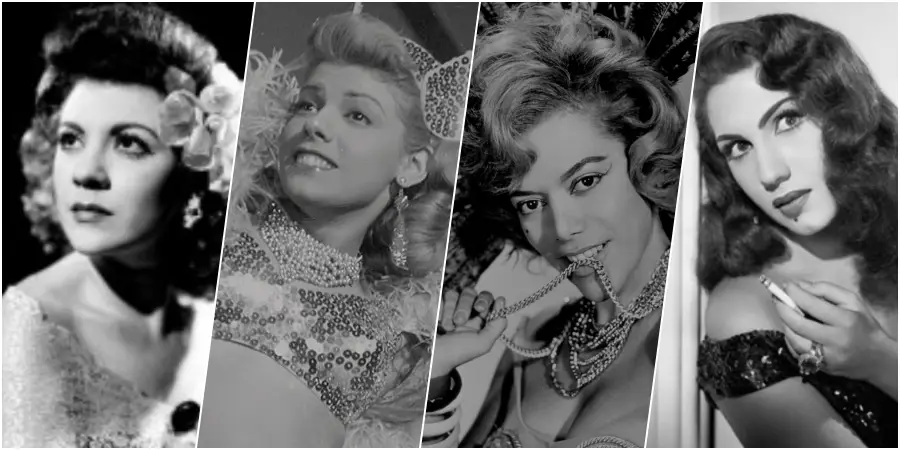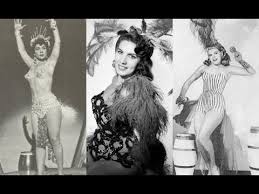
De izquierda a derecha, las actrices y bailarinas cubanas María Antonieta Pons, Ninón Sevilla, Amalia Aguilar y Rosa Carmina (Fotostomadas de la Filmoteca UNAM y la Mediateca INAH).
“EL CINE DE RUMBERAS” Y SUS CUBANAS EN LA EPOCA DE ORO DEL CINE MEXICANO. VIDEOS/ PHOTOS.
Las rumberas cubanas que fundaron un nuevo género de cine en México. El éxito del Cine de Rumberas por casi dos décadas se debe al esplendor, belleza y magnetismo de sus estrellas: cuatro de las más importantes eran cubanas.
MEXICO, D.F. – México puede jactarse de haber legado al mundo algunos géneros cinematográficos endémicos que no se han explorado en ningún otro país. El ejemplo más famoso es quizá el “Cine de Luchadores” de las décadas de 1960 y 1970 del pasado siglo. Pero, sin lugar a dudas, el más prolífico y singular de ellos es el llamado “Cine de Rumberas”.
El Cine de Rumberas es un género cinematográfico que floreció en el marco de la llamada “Época de Oro” del cine mexicano, en los años 1940 y 1950. El género es un híbrido muy curioso surgido de la amalgama de otros géneros fílmicos. Su primer ingrediente es el cine musical, específicamente el que se realizó en Hollywood en la década de 1930, caracterizado por sus números musicales vistosos, con toques de fantasía y cierto surrealismo que no tenían nada que ver con la trama.
El segundo elemento que lo insufla es el Film Noir (cine negro): cine de tipo urbano con tramas de corte policíaco en donde las figura del gángster y la femme fatal eran elementos centrales de la trama. Y el tercer elemento que lo conforma es el melodrama urbano que, dentro del cine mexicano, fue perfilado por el cineasta Alejandro Galindo, creador de una serie de películas de corte arrabalero de los años 1940 y 1950, cuya trama ensalzaba la figura de los personajes de corte popular, los “ídolos de barrio”.
Paralelamente, el género se adereza con música. En ese momento, Cuba ya se había establecido como núcleo de la música tropical en el mundo, y la rumba cubana dominaba musicalmente en Latinoamérica. De la Isla también llegó el bolero. Y en México, una de las figuras centrales de este género fue el llamado “músico-poeta” Agustín Lara.
Lara comenzó su carrera como cantante y pianista en los cabarets y casas de citas. Muchas de sus composiciones están inspiradas en las trabajadoras sexuales que conoció en aquellos años. Los títulos y las letras de sus temas ―Aventurera, Coqueta, Perdida…―, estimularon la imaginación de los guionistas del cine mexicano.
Si ponemos todos estos ingredientes en una suerte de “licuadora imaginaria”, el resultado es el Cine de Rumberas.
Pese a esta singular mezcla de géneros, las películas del Cine de Rumberas tienen el mismo tic genérico: cada filme, con ligeras variantes, cuenta la tragedia de una joven mujer que, “por oscuros caprichos del destino”, cae en desgracia y termina arrastrada a “la perdición” (representada por algún cabaret). Allí, algún proxeneta o madame la explotaban sin piedad. Como catarsis de su desgracia, la desdichada mujer bailaba rumba, mambo, samba o algún otro ritmo tropical, encontraba el amor y luego la vida le permitía pasar de víctima a victimaria. En la mayoría de las veces terminaba su historia en tragedia, pues una “mala mujer” no podía triunfar ante los ojos de un público moralista. La “pecadora” pagaba el precio de “vender caro su amor”.
“CINE DE RUMERAS” (RUMBERA CINEMA) AND ITS CUBANS IN THE GOLDEN AGE OF MEXICAN CINEMA. VIDEOS/PHOTOS.
The Cuban rumberas who founded a new cinematic genre in Mexico. The success of Rumbera Cinema for almost two decades is due to the splendor, beauty, and magnetism of its stars: four of the most important were Cuban.
MEXICO CITY – Mexico can boast of having bequeathed to the world some endemic cinematic genres that have not been explored in any other country. The most famous example is perhaps the “Wrestler Cinema” of the 1960s and 1970s. But, without a doubt, the most prolific and unique of these is the so-called “Cinema of Rumberas.”
Cinema of Rumberas is a film genre that flourished during the so-called “Golden Age” of Mexican cinema, in the 1940s and 1950s. The genre is a very curious hybrid that emerged from the amalgamation of other film genres. Its first ingredient is musical cinema, specifically the one made in Hollywood in the 1930s, characterized by showy musical numbers, with touches of fantasy and a certain surrealism that had nothing to do with the plot.
The second element that informs it is Film Noir: urban cinema with detective plots where the figures of the gangster and the femme fatale were central elements of the plot. And the third element that makes it up is the urban melodrama, which, within Mexican cinema, was outlined by filmmaker Alejandro Galindo, creator of a series of suburban films from the 1940s and 1950s, whose plots extolled the figures of popular characters, the “neighborhood idols.”
At the same time, the genre is spiced up with music. At that time, Cuba had already established itself as the center of tropical music worldwide, and Cuban rumba dominated Latin America. Bolero also came from the island. And in Mexico, one of the central figures of this genre was the so-called “musician-poet” Agustín Lara.
Lara began his career as a singer and pianist in cabarets and brothels. Many of his compositions are inspired by the sex workers he met during those years. The titles and lyrics of their songs—Adventurer, Coquette, Lost…—stimulated the imagination of Mexican screenwriters.
If we put all these ingredients into a sort of “imaginary blender,” the result is the Cine de Rumberas (Rumba Cinema).
Despite this unique mix of genres, the films of Cine de Rumberas (Rumba Cinema) have the same generic tic: each film, with slight variations, tells the tragedy of a young woman who, “by dark whims of fate,” falls into disgrace and ends up dragged to “perdition” (represented by some cabaret). There, some pimp or madam exploited her mercilessly. As a catharsis for her misfortune, the unfortunate woman danced rumba, mambo, samba, or some other tropical rhythm, found love, and then life allowed her to go from victim to victimizer. Most of the time, her story ended in tragedy, since a “bad woman” could not triumph in the eyes of a moralistic public. The “sinner” paid the price for “selling her love dearly.”

Agencies/ Wiki/ Cubanet/ Luis M.Romero Castillo/ Extractos/ Excerpts/ Internet Photos/ YouTube/ www.TheCubanHistory.com/ Arnoldo Varona.
THE CUBAN HISTORY, HOLLYWOOD.



